 |
 |
 |
| |
Efficacy and Safety By Racial Group in ARV-Naive Subjects Treated With Atazanavir/Ritonavir or Lopinavir/Ritonavir:
48-Week Results for the CASTLE Study
|
| |
| |
Ola
Reported by Jules Levin
IAS, Mexico City, Aug 3-8, 2008
from JulesBlacks Have Better Lipids Responses Than Whites to Both Reyataz and Kaletra
AUTHOR CONCLUSIONS
Both once-daily ATV/RTV and twice-daily LPV/RTV regimens demonstrated overall high levels of virologic response and robust increases in CD4 cell count, but the regimens varied in efficacy and immunologic response by race/ethnicity.
As anticipated, direct hyperbilirubinemia occurred more frequently with ATV/RTV than with LPV/RTV, but was not treatment-limiting.
The rates of direct hyperbilirubinemia (all grade and grade 3-4) were slightly higher among whites than other ethnic groups, but were consistent with previous studies of ATV/RTV.
As anticipated, patients on ATV/RTV had fewer gastrointestinal AEs regardless of race/ethnicity; among patients receiving LPV/RTV diarrhea was highest for white patients (14%) and lowest for black patients (5%).
Patients receiving ATV/RTV had less elevation in total cholesterol, non-HDL cholesterol, and triglycerides regardless of race/ethnicity.
The impact on some lipid parameters varied widely by race/ethnicity for ATV/RTV and LPV/RTV: Asian patients receiving LPV/RTV had a 100% increase in triglycerides, whereas black patients receiving ATV/RTV had no increase.
While both ATV/RTV and LPV/RTV regimens show high levels of efficacy in all race/ethnicities at 48 weeks, variations in safety profiles, particularly gastrointestinal tolerability and increases in lipid parameters, discriminated between the 2 boosted PIs.
These differences provide important information for clinicians to consider when selecting regimens intended for long-term control of HIV infection.
Lipid Parameters
The percent increase in total cholesterol from baseline to Week 48 was 19% among blacks and Asians (both groups) receiving LPV/RTV, compared with 3% and 6%, respectively, for ATV/RTV.
In the LPV/RTV group white patients had a 27% increase in total cholesterol and patients in the other racial/ethnic group had a 30% increase, compared with 15% and 17% increases, respectively, for patients in the white and other
racial/ethnic groups receiving ATV/RTV.
The most notable racial/ethnic trend in the data was an increase in triglycerides from baseline to Week 48 in the LPV/RTV group noted as a 100% increase in Asian patients and 60% increases in the white and other racial/ethnic groups.
By contrast, triglyceride levels increased by 17% in whites, 0% in blacks, 21% in Asian, and 11% in the other racial/ethnic group treated with ATV/RTV.
Figure 3 shows change from baseline in fasting lipids (mg/dL) at Week 48 by
treatment regimen and race/ethnicity.
Virologic and Immunologic Responses
Virologic response rates to the regimens were consistently high across all
racial/ethnic subgroups (Table 1).
The magnitude of immunologic response (median increase in CD4 cell count)
was lowest among black patients for both regimens (Table 1).
Adverse Events
AEs were not treatment-limiting in most cases; the incidence of AEs leading to
discontinuation of study therapy was low in the overall population (2% ATV/RTV and 3% LPV/RTV).
Ð More patients receiving ATV/RTV discontinued due to jaundice/ hyperbilirubinemia (< 1% vs 0), while more patients receiving LPV/RTV discontinued due to diarrhea (< 1% vs 0).
Grade 2 to 4 treatment-related AEs stratified by race/ethnicity and treatment
arm are shown in Table 2.
Overall, the incidences of jaundice and hyperbilirubinemia (all grades) were lowest in blacks (2% and 4%, respectively) and highest in Asians (26% and
40%, respectively) in the ATV/RTV group.
Table 3 shows all grade and grade 3 to 4 laboratory abnormalities in bilirubin.
Introduction
Race-based differences in efficacy and safety have been reported among
HIV-infected individuals receiving highly active antiretroviral therapy (HAART), but data from randomized clinical trials are limited.1-3
Globally, there is a growing increase in obesity, diabetes, and the metabolic syndrome, and there are reports that certain ethnic groups may be more
susceptible to the risks posed by these conditions.4,5
Atazanavir-boosted with ritonavir (ATV/RTV) is a potent, generally well-tolerated,
once-daily HIV-1 protease inhibitor (PI) extensively studied in treatment-naive
and treatment-experienced patients.6-8
CASTLE demonstrated that in combination with tenofovir disoproxil fumarate/
emtricitabine, ATV/RTV is noninferior to lopinavir/RTV (LPV) in antiviral efficacy in treatment-naive patients at 48 weeks, with significantly less elevation of lipids and better gastrointestinal (GI) tolerability.8
This large-scale study provides the opportunity to assess potential differences
in treatment efficacy and safety among antiretroviral-naive HIV-infected patients
from a number of racial/ethnic backgrounds.
Objective
To analyze the CASTLE 48-week efficacy and safety data by racial/ethnic group
and to assess the virologic, immunologic, and safety profiles of both an ATV/RTV-based regimen and an LPV/RTV-based regimen.
Methods
CASTLE is a randomized, open-label, prospective study comparing once-daily
ATV/RTV with twice-daily LPV/RTV, both in combination with fixed-dose
tenofovir/emtricitabine (TDF/FTC) in treatment-naive HIV-infected patients (Figure 1).
The primary end point was proportion of patients with HIV RNA < 50 c/mL at
Week 48.
The proportion of patients with HIV RNA < 50 c/mL (confirmed virologic
response [CVR], noncompleter equals failure [NC = F]), CD4 cell count
changes, adverse events (AEs), and fasting lipid changes are presented by
race through Week 48 for this analysis.
Demographic data collected at baseline included race and ethnicity categorized
as white, black, Asian, or other.
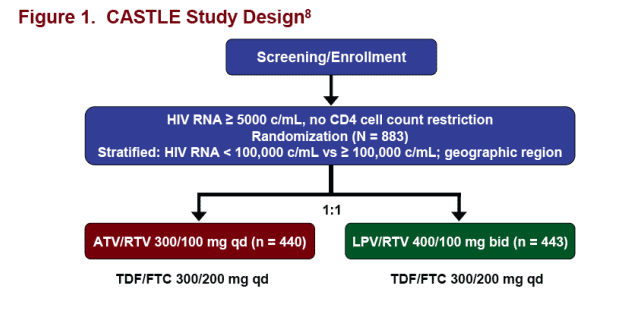
Of 883 randomized patients, 48% were white, 18% were black, 9% were Asian,
and 24% were other (comprising Hispanic/Latino 6%, Mestizo 67%, mixed race 27%).
Racial/ethnic classification was similar between the 2 treatment arms.
Virologic and Immunologic Responses
Total Study Population
In the primary analysis, once-daily ATV/RTV was noninferior to twice-daily
LPV/RTV (Figure 2).
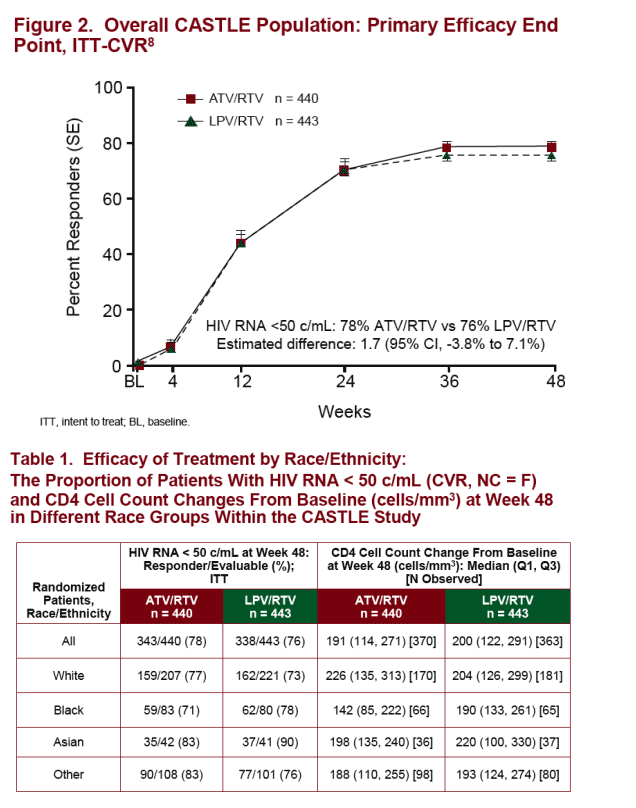
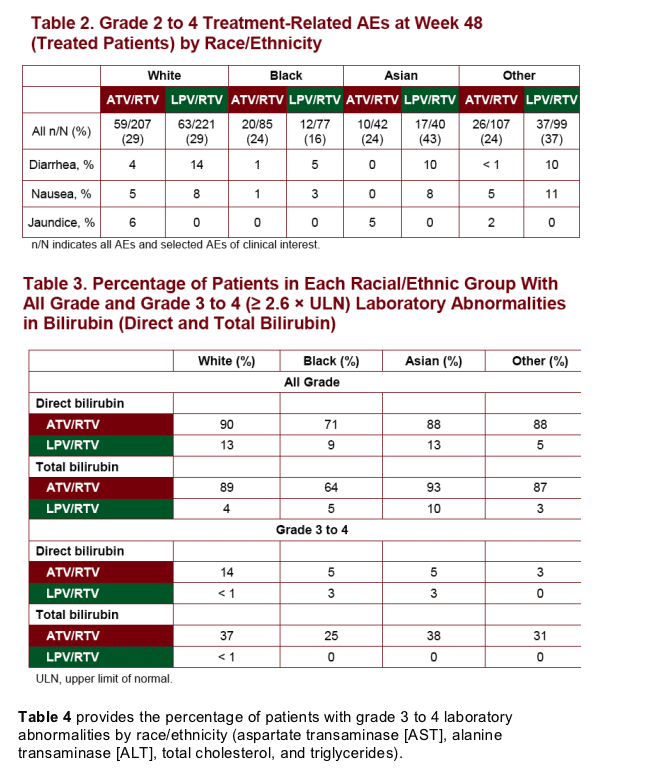
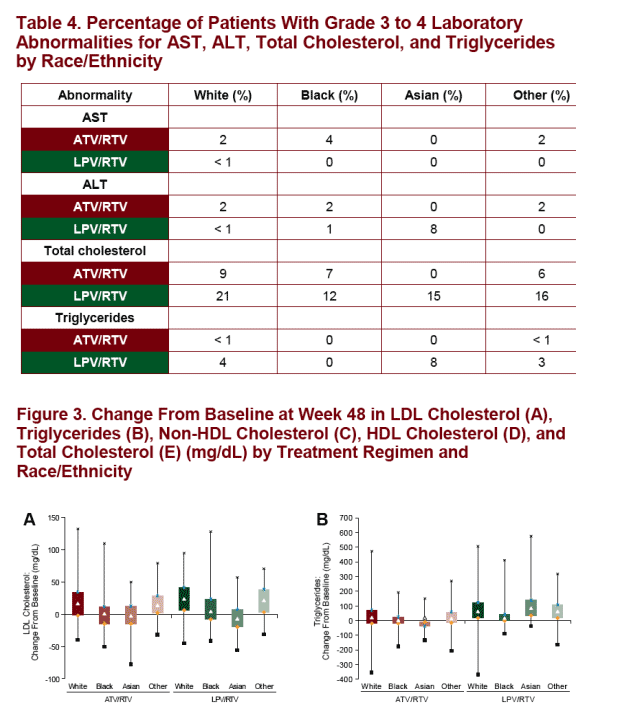
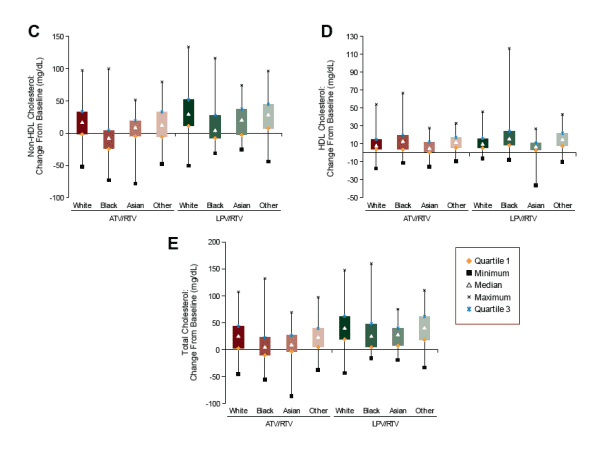
|
| |
|
 |
 |
|
|